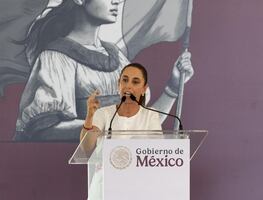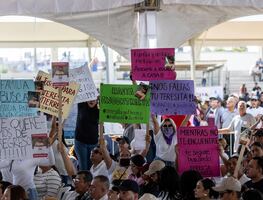Más Información

Osiel Cárdenas, exlíder del Cártel del Golfo, recibe auto de formal prisión; enfrentará juicio por homicidio

Jóvenes mexicanos pasan más de 2 mil horas al año en el teléfono; OCDE alerta sobre su impacto en la salud mental

Sergio Gutiérrez Luna destaca aprobación de 25 reformas en la 66 Legislatura; "Un logro histórico para la 4T", señala

Secretario de Agricultura reafirma defensa del maíz blanco; "Seguiremos apoyando la producción nacional no transgénica", afirma

¿Maíz transgénero? Rubén Rocha corrige desliz durante discurso en Sinaloa; destaca importancia del maíz blanco

Sheinbaum asegura apoyo total a Sinaloa para enfrentar violencia; "Nunca los vamos a dejar solos, aquí está la presidenta"
There are over 20 species of crocodiles in the world and three of them inhabit Mexico. The biologist Hesiquio Benítez , managing director of CONABIO ( National Commission for the Knowledge and Use of Biodiversity ), explains that the Morelet’s crocodile, which is endemic to Mexico and thus known as the Mexican crocodile , lives mainly in the coast of the Gulf of Mexico and the Yucatán peninsula all the way to Chiapas.
In the case of the American crocodile, the species is gathered in Sinaloa but covers all the Pacific coast and the Yucatán peninsula. The third species is the spectacled caiman, which can only be found in the state of Chiapas. All three species are very different, but the Morelet’s crocodile has a certain particularity that makes it unique and highly valued: its skin is of excellent quality and is among the three best crocodile skins in the world.
This quality has been put to use in a pilot project that seeks to produce Morelet’s crocodile skin in Mexico. The common land of Chacchobén in the state of Quintana Roo had become the first place in the country to obtain its UMA certificate (Sustainable Management Unit for Wildlife Preservation), for the preservation and sustainable use of this species.
Morelet’s crocodiles reproduce only once a year. Between February and April, their mating begins, and around May and June, depending on the size of the female, they lay 35 eggs in nests made of fallen leaves and organic waste.
Up to that point, their story is relatively simple, but things get complicated shortly, given that the probability of birth and survival of the offspring in the wild is barely 10%. However, through very specific care in incubators and post-birth protection, the survival rate may increase up to 90%.
Hesiquio Benítez points out that, although all three species of crocodiles that inhabit Mexican territory were in danger of extinction in the 70s, a series of measures and prohibitions were implemented to enable their recovery. Through annual monitoring coordinated by CONABIO along with a group of specialists from academic institutions, the species is known to be no longer in danger. As a result, the United States government lifted the ban to enable the import of the species’ sub-products.
It is estimated that a population of around 70 thousand Morelet’s crocodiles live in the wild, without taking into account those that live in farms. “The research was validated by scientists from the International Union for Conservation of Nature (IUCN),” Benítez stresses that by no means does the research imply that Mexico will allow the hunting of crocodiles; on the contrary, what is being proposed is the sustainable use of the species through the collection of eggs and care for the species through monitoring and specific consultation.
A Sustainable Strategy
Benítez explains that the model implemented through the UMAs has already been successfully implemented in other countries such as Australia, the US, South Africa, Argentina, Colombia, and Venezuela: “It is a useful and generous practice, given that the survival rate of the species is considerably high. We have gone from a loss-taking scenario to a profitable one. On top of that, when these animals are fed and cared for in the right way, they grow extremely faster than they would in the wild, producing a skin of excellent quality which is paid at high prices in the international market.”
CONABIO expects that through the model of the UMAs, crocodile skin can be produced and bring benefits to the communities which should, in turn, commit themselves to the preservation of the ecosystems the species inhabits. “In this particular case, they are committing to the protection of over nine thousand acres of the crocodile’s natural habitat. This strategy seeks to avoid the destruction of jungles through sowing and will allow the recovery of an ecosystem that, in optimal conditions, helps to withhold hurricanes, serves as a “nursery” for the fish, increases the level of pollinating species, provides wood and, in general, brings opportunity to the communities.”
In addition to Crocodilia, the farm where the offspring is taken for their care and the completion of their productive cycle, this project also includes the cooperation of the Responsible Ecosystems Sourcing Platform (RESP) , a Swiss organization that brings together several brands of the fashion industry that have taken an interest in sustainable, legal and traceable crocodile skin. “They have decided to bring one of their first projects to Mexico. This is the first time that the project is made on an international level.”
The pilot project is contemplated for the next three years. Benítez states that the management plan has already been written, revised and approved, but there are yet many details to be defined on both parts. The government of Quintana Roo is also interested in supplying resources and to offer assistance in four lines of work: To continue monitoring the species, to expand the preservation model, to supply equipment and training to the landowners, and to offer their support to the farm. After the first period, the communities will be expected to continue with the project on their own, abiding by the environmental agreements.
“The world market trades around a million and a half crocodile skins . Mexico sells two thousand or less, which is almost nothing. We have enormous potential because the quality of our crocodile skin is far better than that of the United States, among others.” Benítez says that the prices on Morelet’s crocodile skin may vary, but are valued at around 15 dollars per centimeter, when the skin is in perfect conditions. “This commercial activity can detonate many others, such as ecotourism based on programs of environmental education. This may be an important contribution to rural communities.”
Mexico has regulated the fur trade for twenty years through the use of closed-cycle farms, which use only second generation reproductive specimens. “The farms in our country have been working like this for a long time, but their production is minimal, which is why by association with communities which are committed to the preservation of wildlife, they could increase their production.
Two Decades of UMAs
The Sustainable Management Units for Wildlife Preservation (UMAs) are spaces authorized by SEMARNAT (Secretariat of Environment and Natural Resources) . They promote alternative strategies for production, which are compatible with the preservation of wildlife, bringing benefits to the communities that live around an endangered species in exchange for its care and the preservation of its natural habitat. These preservation models have reached their second decade in Mexico. “They offer a wide range of opportunities. In spite of being some of the richest areas in biodiversity, most of these regions are also the poorest”, Benítez points out, specifying that there are over ten thousand UMAs in the country.
To the expert from CONABIO, one of the most successful units is that of the bighorn sheep in northern Mexico. These projects have brought an increase in the population of this species, which is highly prized among hunters. Hunting permits are given depending on the population of sheep and they are auctioned at a high prize, providing a significant income for the communities that protect these animals and their territory. The communities understand the reciprocity that their care implies.
Hesiquio Benítez believes that their challenge is to diversify these programs, which requires a better knowledge of the species and of their environment. “We have iguanas, snakes, tarantulas, among many other species which are illegally included in the international trade. With the proper care, we ought to make better use of the great biodiversity we possess, because prohibition often comes from ignorance. The legal way to do this is to have good management plans that lean on the preservation of wildlife.”
dm




